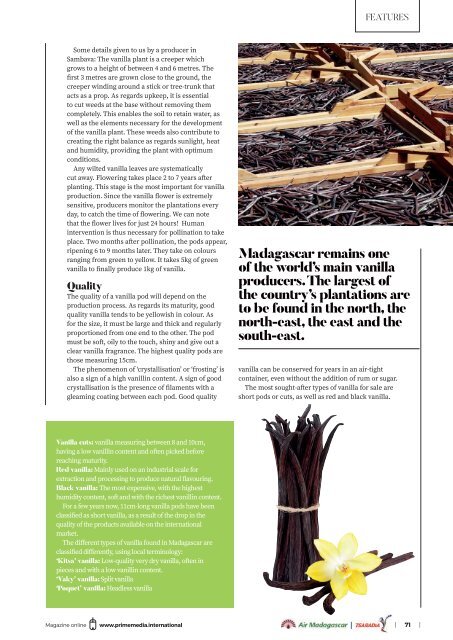Prime-Magazine-August-2019
You also want an ePaper? Increase the reach of your titles
YUMPU automatically turns print PDFs into web optimized ePapers that Google loves.
FEATURES<br />
Some details given to us by a producer in<br />
Sambava: The vanilla plant is a creeper which<br />
grows to a height of between 4 and 6 metres. The<br />
first 3 metres are grown close to the ground, the<br />
creeper winding around a stick or tree-trunk that<br />
acts as a prop. As regards upkeep, it is essential<br />
to cut weeds at the base without removing them<br />
completely. This enables the soil to retain water, as<br />
well as the elements necessary for the development<br />
of the vanilla plant. These weeds also contribute to<br />
creating the right balance as regards sunlight, heat<br />
and humidity, providing the plant with optimum<br />
conditions.<br />
Any wilted vanilla leaves are systematically<br />
cut away. Flowering takes place 2 to 7 years after<br />
planting. This stage is the most important for vanilla<br />
production. Since the vanilla flower is extremely<br />
sensitive, producers monitor the plantations every<br />
day, to catch the time of flowering. We can note<br />
that the flower lives for just 24 hours! Human<br />
intervention is thus necessary for pollination to take<br />
place. Two months after pollination, the pods appear,<br />
ripening 6 to 9 months later. They take on colours<br />
ranging from green to yellow. It takes 5kg of green<br />
vanilla to finally produce 1kg of vanilla.<br />
Quality<br />
The quality of a vanilla pod will depend on the<br />
production process. As regards its maturity, good<br />
quality vanilla tends to be yellowish in colour. As<br />
for the size, it must be large and thick and regularly<br />
proportioned from one end to the other. The pod<br />
must be soft, oily to the touch, shiny and give out a<br />
clear vanilla fragrance. The highest quality pods are<br />
those measuring 15cm.<br />
The phenomenon of ‘crystallisation’ or ‘frosting’ is<br />
also a sign of a high vanillin content. A sign of good<br />
crystallisation is the presence of filaments with a<br />
gleaming coating between each pod. Good quality<br />
Madagascar remains one<br />
of the world’s main vanilla<br />
producers. The largest of<br />
the country’s plantations are<br />
to be found in the north, the<br />
north-east, the east and the<br />
south-east.<br />
vanilla can be conserved for years in an air-tight<br />
container, even without the addition of rum or sugar.<br />
The most sought-after types of vanilla for sale are<br />
short pods or cuts, as well as red and black vanilla.<br />
Vanilla cuts: vanilla measuring between 8 and 10cm,<br />
having a low vanillin content and often picked before<br />
reaching maturity.<br />
Red vanilla: Mainly used on an industrial scale for<br />
extraction and processing to produce natural flavouring.<br />
Black vanilla: The most expensive, with the highest<br />
humidity content, soft and with the richest vanillin content.<br />
For a few years now, 11cm-long vanilla pods have been<br />
classified as short vanilla, as a result of the drop in the<br />
quality of the products available on the international<br />
market.<br />
The different types of vanilla found in Madagascar are<br />
classified differently, using local terminology:<br />
‘Kitsa’ vanilla: Low-quality very dry vanilla, often in<br />
pieces and with a low vanillin content.<br />
‘Vaky’ vanilla: Split vanilla<br />
‘Poquet’ vanilla: Headless vanilla<br />
<strong>Magazine</strong> online www.primemedia.international | 71 |

















